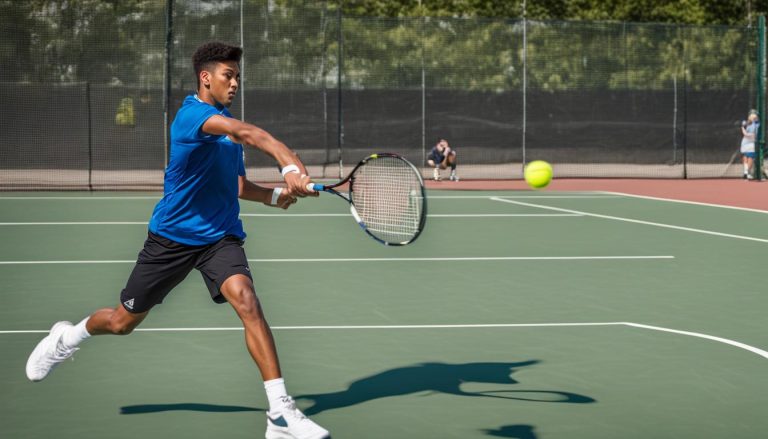Building Stamina and Speed for Tennis: Training Tips
Enhancing stamina and speed is essential for any tennis player looking to improve their performance on the court. By incorporating specific training techniques and exercises into your fitness regime, you can optimize your endurance and agility, gaining a competitive edge in the game.
In this article, we will explore various training tips and exercises that are specifically designed to build stamina and speed in tennis. From endurance workouts and conditioning drills to agility drills and tennis-specific exercises, we will provide you with a comprehensive tennis training program that will help you take your game to the next level.
To increase your tennis speed, it is important to focus on both aerobic and anaerobic training. By implementing a combination of these training methods, you can improve your cardiovascular fitness, explosiveness, and overall anaerobic capacity.
Whether you are a professional athlete or a recreational player, this article will provide you with valuable insights and guidance on how to effectively train for stamina and speed in tennis. So, let’s dive in and explore the world of tennis endurance exercises, conditioning drills, agility training, and more!
The Importance of Aerobic and Anaerobic Training
Building stamina and speed in tennis requires a combination of aerobic and anaerobic training. Although they target different aspects of fitness, both forms of training play a crucial role in enhancing a player’s performance on the court.
Aerobic training focuses on improving cardiovascular fitness and endurance. It involves exercises that increase heart rate and breathing for an extended period, such as steady-state aerobic training. This type of training helps strengthen the cardiovascular system, improves oxygen delivery to the muscles, and enhances overall endurance.
Anaerobic training, on the other hand, emphasizes explosiveness, responsiveness, and anaerobic capacity. It involves high-intensity activities that push the body to its limits, such as sprinting or performing quick bursts of intense movements. Anaerobic training helps tennis players develop the power and speed needed for explosive shots and fast court coverage.
“Aerobic and anaerobic training are both essential for tennis players to build stamina and speed.”
A popular training method that combines both aerobic and anaerobic elements is high-intensity interval training (HIIT). HIIT involves alternating between short, intense bursts of exercise followed by brief rest periods. This type of training stimulates both the aerobic and anaerobic energy systems, resulting in improved overall fitness and performance.
However, it is important to note that tennis players should not solely rely on HIIT and anaerobic training. While anaerobic exercise can be highly effective in developing explosive power, it is still vital to maintain a certain level of aerobic conditioning to meet the demands of the sport.
Understanding the physiological aspects of tennis is essential for designing an effective training program. By incorporating both aerobic and anaerobic training methods, players can optimize their performance on the court and achieve their full potential.
Aerobic Training vs. Anaerobic Training
| Aerobic Training | Anaerobic Training |
|---|---|
| Improves cardiovascular fitness and endurance | Develops explosiveness and anaerobic capacity |
| Steady-state aerobic training | High-intensity burst exercises |
| Enhances oxygen delivery to muscles | Builds power and speed for explosive movements |
| Longer duration, lower intensity | Short duration, high intensity |
Endurance Exercises for Tennis Players
Building stamina is vital for any tennis player aiming to enhance their performance on the court. Endurance exercises play a crucial role in developing the necessary cardiovascular fitness and muscle strength to sustain long, intense matches. One foundational exercise that is particularly effective for building endurance is the long slow run.
The long slow run is a low-intensity, steady-state aerobic exercise that targets the cardiovascular system and promotes overall tennis fitness. By engaging in this type of exercise regularly, players can strengthen their heart, improve oxygen delivery to the muscles, and enhance their energy efficiency on the court.
In addition to cardiovascular benefits, the long slow run also helps improve joint and muscle strength. The repetitive nature of the exercise builds resilience and endurance in the muscles and joints, reducing the risk of injuries and enhancing overall physical performance.
Beyond joint and muscle strength, the long slow run is also an effective exercise for promoting fat burning. As the body engages in prolonged low-intensity activity, it taps into stored fat as a source of energy, supporting weight management and body composition goals.
Incorporating endurance exercises, such as the long slow run, into a tennis player’s training routine can significantly contribute to their overall stamina and tennis fitness. By consistently challenging and improving their cardiovascular system, joint and muscle strength, fat burning capability, and energy efficiency, players can optimize their on-court performance and stay competitive.
| Benefits | Description |
|---|---|
| Improved Cardiovascular Fitness | The long slow run strengthens the heart and enhances oxygen delivery to the muscles, improving overall cardiovascular fitness. |
| Enhanced Joint and Muscle Strength | The repetitive nature of the exercise builds resilience and endurance in the muscles and joints, reducing the risk of injuries and enhancing overall physical performance. |
| Promotes Fat Burning | The long slow run taps into stored fat as a source of energy, supporting weight management and body composition goals. |
| Improved Energy Efficiency | Consistently challenging and improving the body’s energy systems can enhance overall energy efficiency during tennis matches. |
Speed and Agility Training for Tennis
Enhancing speed and agility is essential for improving overall performance in tennis. By incorporating specific training techniques, players can enhance their on-court movement, reactiveness, and quickness. Speed and agility training methods include interval training, footwork drills, sprinting drills, and strength exercises that focus on explosive movements.
Interval Training: Interval training involves alternating between high-intensity sprints and rest periods, allowing players to improve both speed and endurance. This type of training mimics the intensity of a tennis match, helping players sustain their performance throughout long rallies.
Footwork Drills: Footwork drills that simulate on-court movements are designed to improve players’ agility and quickness. These drills focus on lateral movements, changes in direction, and rapid acceleration and deceleration.
Strength Exercises: Exercises like deadlifts and kettlebell swings improve overall strength and power, enhancing force generation for quick directional changes and explosive movements on the court. These exercises target the lower body muscles, which are vital for efficient footwork and swift movements.
By incorporating a variety of speed and agility training techniques into their tennis fitness program, players can significantly enhance their on-court performance and gain a competitive edge.

| Speed and Agility Training Exercises | Benefits |
|---|---|
| Interval Training |
|
| Footwork Drills |
|
| Strength Exercises |
|
Strength Training for Tennis
Strength training is a crucial component of a well-rounded tennis fitness routine. By incorporating specific exercises that target upper body and core strength, as well as power and conditioning in the lower body, players can enhance their performance on the court.
One effective exercise for developing power and conditioning in the lower body is pogo jumps. These explosive jumps engage the quads, hamstrings, and calves, building strength and helping to improve agility and quickness. Performing sets of pogo jumps can help tennis players generate power from the legs, enabling more explosive movements during play.
To develop upper body strength, weighted chin-ups are an excellent exercise. By adding resistance to the chin-up movement, players can target the muscles in the back, shoulders, and arms, improving overall upper body strength and stability. This exercise helps tennis players maintain proper posture and generate more power during strokes and serves.
Another exercise that enhances both upper body and core strength is medicine ball throws. By incorporating various throwing movements with a medicine ball, players can strengthen the muscles in the chest, shoulders, and core, improving stability and rotational power. These exercises are particularly beneficial for shots that require upper body rotation, such as groundstrokes and volleys.
By including strength training exercises like pogo jumps, weighted chin-ups, and medicine ball throws in your tennis training program, you can enhance your overall performance on the court. Improving upper body and core strength, as well as power and conditioning in the lower body, will help you generate more power, maintain stability, and excel in your game.
Strength Training for Tennis – Exercise Summary
| Exercise | Main Muscles Targeted | Benefits |
|---|---|---|
| Pogo Jumps | Quads, Hamstrings, Calves | – Builds power and conditioning – Improves agility and quickness |
| Weighted Chin-ups | Back, Shoulders, Arms | – Develops upper body strength – Enhances stability and posture |
| Medicine Ball Throws | Chest, Shoulders, Core | – Increases upper body and core strength – Enhances rotational power and stability |
Conclusion
Building stamina and speed in tennis is essential for maximizing performance on the court. By incorporating a well-rounded training program that includes aerobic and anaerobic exercises, endurance workouts, speed and agility drills, and strength training, tennis players can significantly enhance their overall game.
It is important to consult with a professional coach or trainer to personalize your training program based on your specific needs and goals. A personalized approach will ensure that you are targeting the areas that require improvement and optimizing your training for success. Dedication and consistency are key, as progress takes time, but with the right guidance and commitment, you can reach new levels of performance.
Remember, the journey to building stamina and speed in tennis is a continuous process. Regularly reassess your training program and make adjustments as necessary. Stay focused, motivated, and disciplined in your training regimen, and the results will come. Whether you are an aspiring professional or a recreational player, investing in your physical fitness and pushing your limits will undoubtedly elevate your tennis game.







